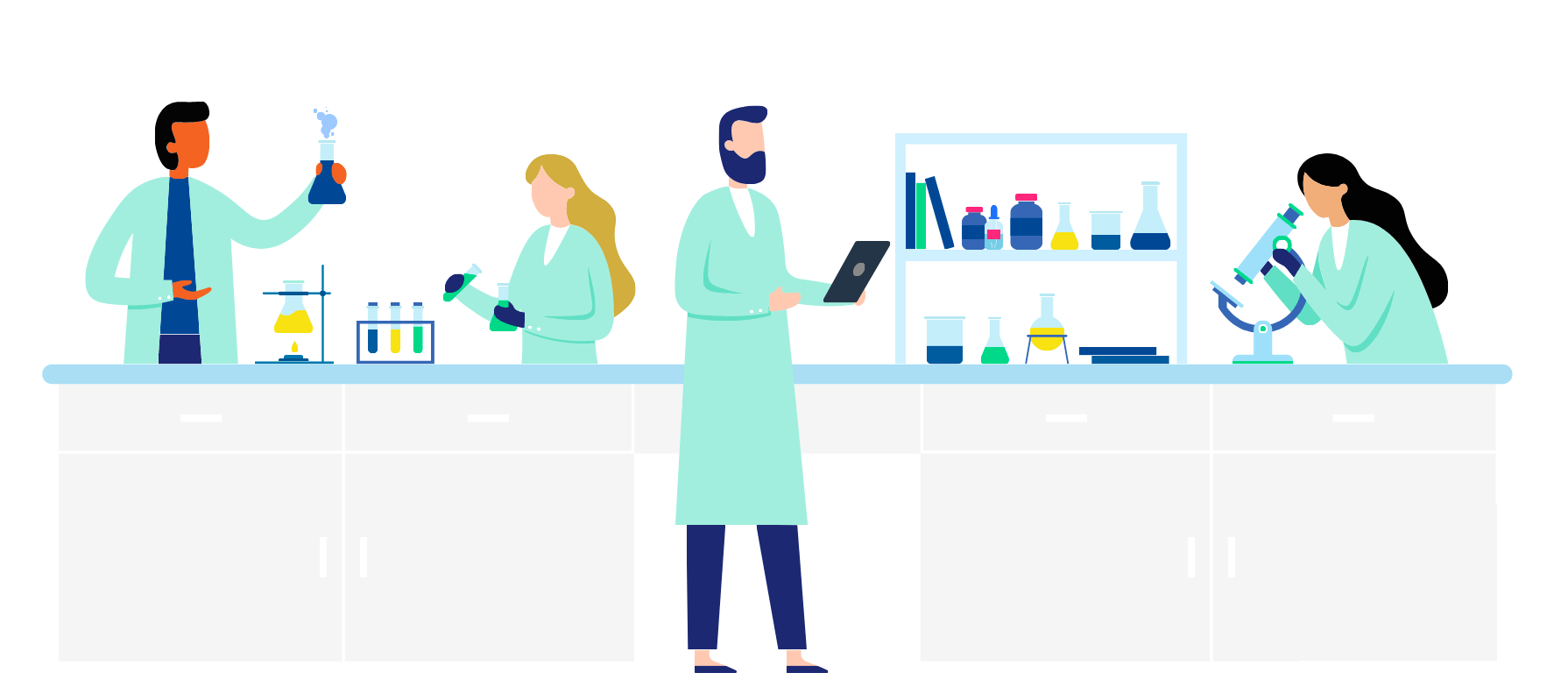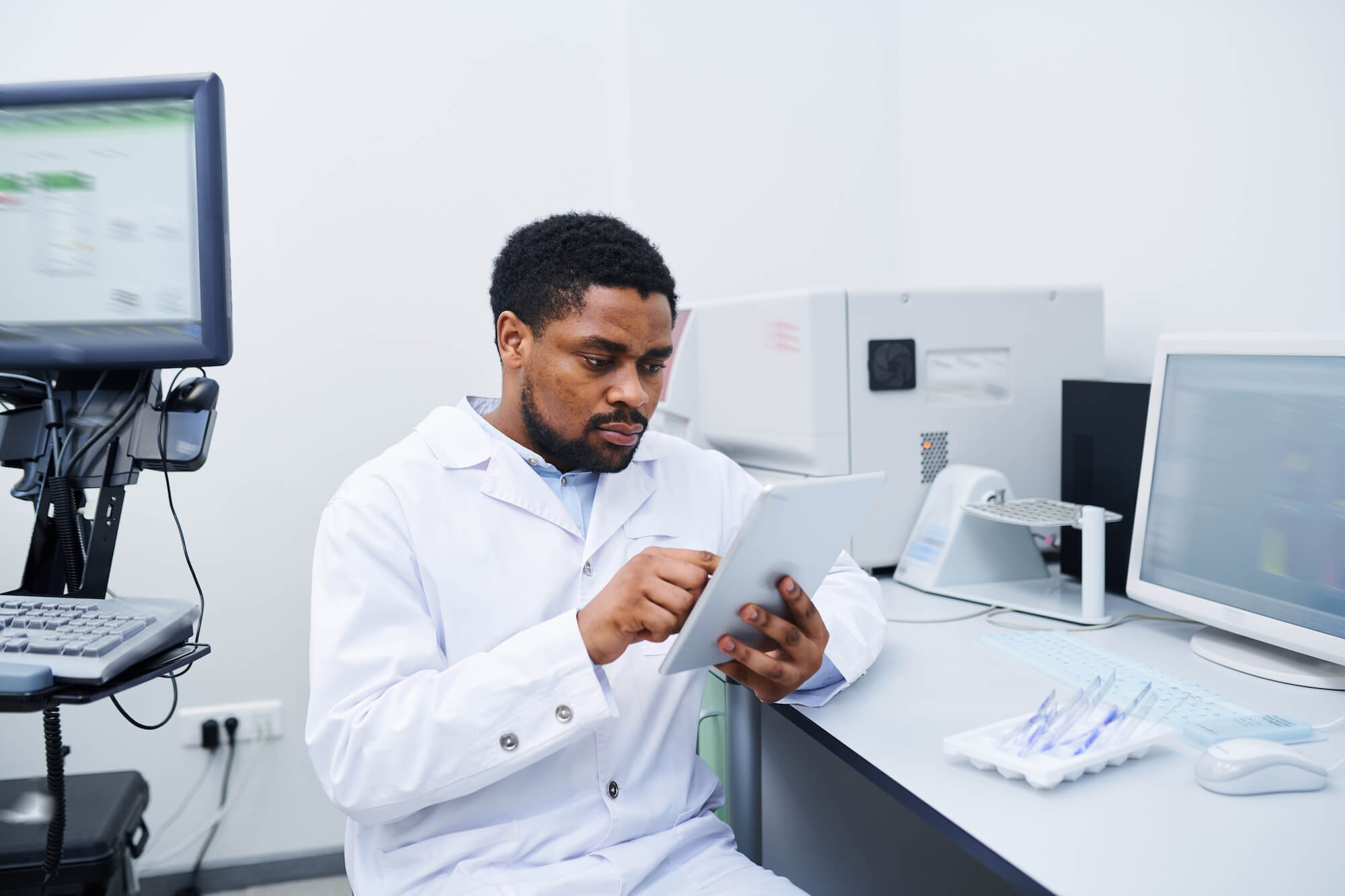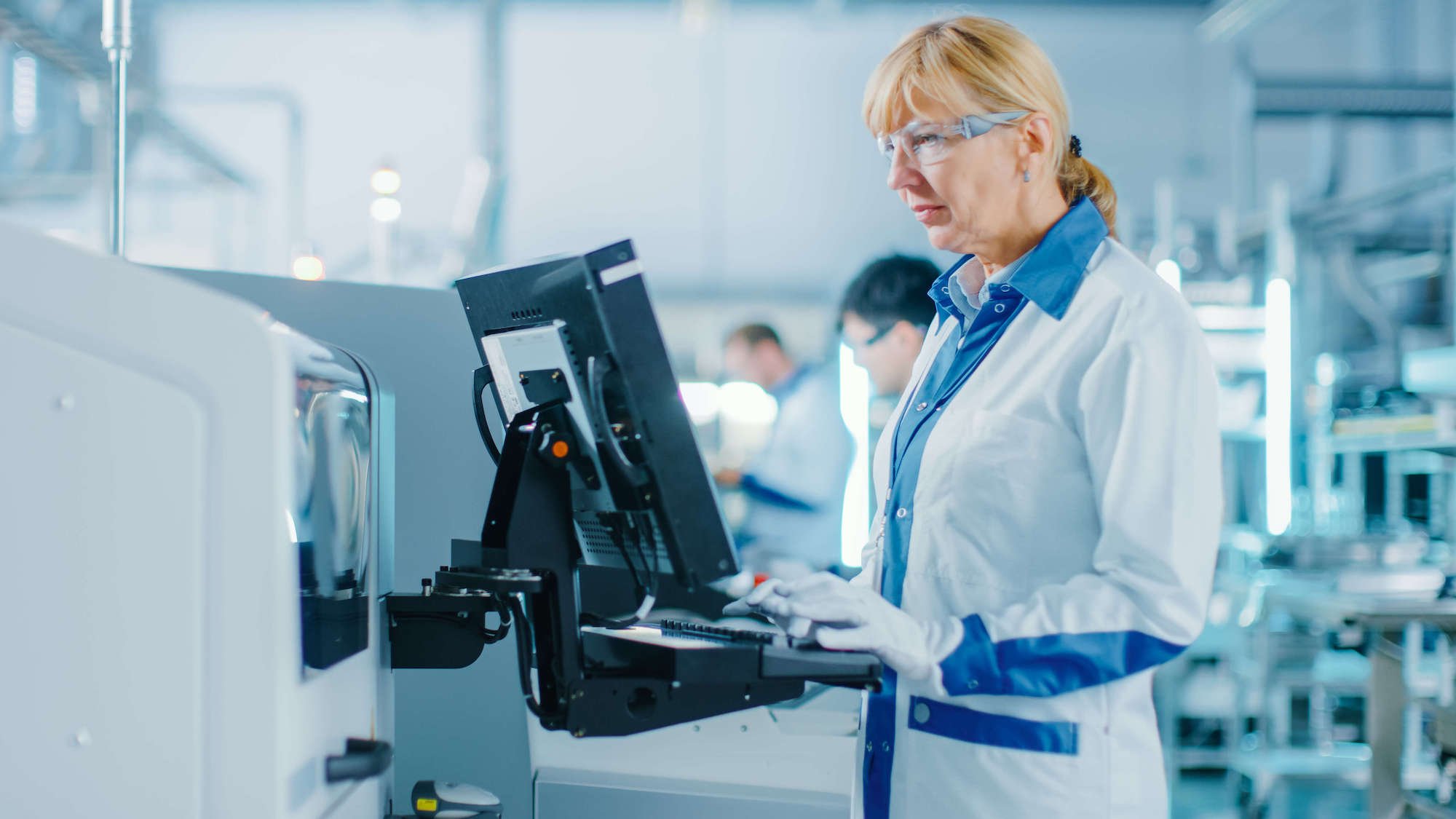Headline
Add text here
Headline
Add text here
Add text here
Add text here

Understand the components and benefits of a LIMS, the differences that a software-as-a-service LIMS brings, and best practices for evaluating if your lab is ready for LIMS.
A laboratory information management system (LIMS) is a platform built around a centralized database of samples. A LIMS solution digitally records and tracks metadata, results, workflows, and instruments associated with lab samples. Laboratories use LIMS to remain compliant with top standards and streamline their lab processes for efficiency.
This guide reviews the components of LIMS and the process of evaluating and purchasing a LIMS for a laboratory. You'll also review the differences between different LIMS environments: self-hosted, platform-as-a-service, and software-as-a-service.
Laboratories use a laboratory information management system (LIMS) to consistently log, track, record, and report on samples and scientific data. Although testing capabilities related to quality assurance and quality control processes have evolved with technology, the primary function of the LIMS has remained the same: The lab needs to audit a sample through its entire process, from creation, to release, usage and disposal.
LIMS provides a precise level of tracking that helps labs follow with industry best practices. The system automatically records certain data, reducing the manual time spent on logging samples, and more time optimizing their processes for efficiency and accuracy for more reliable results.
Understanding LIMS means keeping these considerations in mind:

Here are the goals that laboratories have to which implementing LIMS can help achieve their goals and meet their everyday needs.
Labs need to document, track, and manage inventory relating to controls and samples. A LIMS can help scientists have what they need, when they need it and reduces the amount of time and propensity for human error that can come with manual data entry.
Having a LIMS allows for monitoring of batch usage and batch performance. It also can track distribution of lots among lab members. For previous similar batches, the system make that data available so that analysis can be conducted in the context of the entire product, not just a single batch.
Scientists can configure their sample inventory and study the impacts of storing at various temperatures and humidities, track that samples are tested appropriately and correctly, and prevent future degradation with data trending. These long-term studies involve developing a years-old complex matrix of testing.
Labs can use a LIMS to check quality of a batch manufacture or the quality of water throughout a distribution system. The system gives reliable traceability for each sample that could potentially be impacted by the detection of unwanted bacteria or inappropriate quality.
Because of its automated documentation, LIMS provides searchable audit trails that accurately document storage of samples, their consumption, results, and their subsequent data analysis.
LIMS provides a high level of transparency with its complete documentation. This provides value for third party audits and customers who require reporting.
Labs can minimize the time they spend documenting samples and spend more time on actual work and analysis. A digital record of all samples saves time and money trying to track down or potentially regenerate necessary samples.
Although they serve similar functions, LIMS and LIS (Laboratory Informatics Software) are typically found in different laboratory settings.
LIMS solutions are implemented in industrial settings that handle batch sampling and follow FDA guidelines and industry best practices (GMP, GLP).
On the other hand, LIS solutions are used in clinical settings and are used to report on individual patient samples. These solutions comply with HIPAA and industry accreditation agencies. It should be noted that some complex LIMS have LIS capabilities.
In addition, LIMS can work with an electronic lab notebook (ELN), used for organizing lab experiments. The two systems can track samples through their processes. ELNs are more specific for individual experiments, whereas LIMS will center around collecting and reporting aggregate sample data.

Lab managers evaluating LIMS software, lab managers should look at the lab's current validation process, as this process sets a lab up for compliance. Then, looking at the LIMS features, driving compliance line up with the laboratory’s needs.
Keep in mind these three areas to understanding how LIMS helps with compliance:
Organization starts with standardizing the data that the lab collects. It's important to define and configure the collection parameters so that all data is standardized and collected consistently.
For example, protocol management for testing stability study samples requires regular collection of complete data to give an accurate depiction of the samples over the the life of the study.
Organization also includes maintenance of chain of custody records throughout the lifecycle of the sample. The use of a LIMS software eliminates the error-prone manual tracking with inconsistent naming conventions. Instead, the lab can scan individual barcodes for better accuracy, consistency, and accountability.
Visualization is used by the lab to report on sample testing and recommend appropriate optimizations for process, which becomes easy when data is digitally collected in a LIMS. Over time, the data may show trends that can identify opportunities for process or compliance improvement. The data is also easily accessible and transparent to everyone in the lab, which allows them to take the action they need to remain compliant.
Visualizations help set and monitor key performance indicators (KPIs), and to obtain a high-level view of the lab and its processes. With KPIs, you can note lab strengths and inefficiencies. Inefficiencies can include lack of training or overworked lab members. Early detection of tthese inefficiencies helps the lab address and correct them before they become larger issues.
LIMS also creates automation of workflow, reducing human error of manual data entry and further detail of documentation. The LIMS can even be implemented with pre-configured workflows that follow industry best practices that are recognized by auditors, and provide tracking from sample creation to completion.
Automation allows your lab to document more details than manual documentation can offer.
The data can be extremely accurate if LIMS can integrate directly with the lab's instrumentation. Any errors in transcription are completely avoided because the documentation occurs at the process. A quality LIMS solution can even flag items that fail specifications so the lab doesn't release it without further review.
These three components with a LIMS creates a comprehensive and accurate audit trail of all samples, any changes, and their results.

Software-as-a-service (SaaS) and cloud computing technologies make lab tools and processes accessible for any laboratory.
With a cloud-based LIMS, labs:
With less time worrying about documentation, the laboratory can actually focus on the science, not the systems.
![]() Rapid deployment: A SaaS LIMS can be fully implemented and deployed in as little as 30 days because of its pre-configured, pre-validated workflows.
Rapid deployment: A SaaS LIMS can be fully implemented and deployed in as little as 30 days because of its pre-configured, pre-validated workflows.
![]() Pre-configured workflows: With pre-validated workflows provided in a LIMS, best practices are already included and ready for deployment, such as barcodes that track samples through the entire testing process.
Pre-configured workflows: With pre-validated workflows provided in a LIMS, best practices are already included and ready for deployment, such as barcodes that track samples through the entire testing process.
![]() Fully validated system: When the system is already validated, it reduces or eliminates the cost and time for required testing, validating, and performing due diligence on requirements and documentation processes.
Fully validated system: When the system is already validated, it reduces or eliminates the cost and time for required testing, validating, and performing due diligence on requirements and documentation processes.
![]() Affordable yet reliable: A SaaS LIMS stores lab data on a secure cloud server, requiring minimal local resources and hardware to operate smoothly. It doesn't require expensive computers to run because you can access the entire system on a browser.
Affordable yet reliable: A SaaS LIMS stores lab data on a secure cloud server, requiring minimal local resources and hardware to operate smoothly. It doesn't require expensive computers to run because you can access the entire system on a browser.
![]() Secure environment for your data: With a traditional LIMS, the laboratory may need to handle the security that incurs additional costs. With a SaaS LIMS, the vendor handles the security of your data.
Secure environment for your data: With a traditional LIMS, the laboratory may need to handle the security that incurs additional costs. With a SaaS LIMS, the vendor handles the security of your data.
![]() Accessible on any browser anywhere: All that is needed for access into a SaaS LIMS is Internet connection, and login credentials without requiring a firewall or VPN operation like you would need with a self-hosted LIMS.
Accessible on any browser anywhere: All that is needed for access into a SaaS LIMS is Internet connection, and login credentials without requiring a firewall or VPN operation like you would need with a self-hosted LIMS.
![]() Data integrity compliance: SaaS LIMS can stay up to date with increasing FDA and MHRA expectations, regulations and guidance for data integrity, including 21 CFR Part 11 and the latest FDA and MHRA Regulatory Data Integrity guidance.
Data integrity compliance: SaaS LIMS can stay up to date with increasing FDA and MHRA expectations, regulations and guidance for data integrity, including 21 CFR Part 11 and the latest FDA and MHRA Regulatory Data Integrity guidance.

A cloud-based LIMS organizes all of your sample information—metadata, workflows, samples, results and instruments—at all times. A SaaS LIMS platform provides flexibility to present your sample data clearly and concisely for a variety of stakeholders.
Your lab should regularly backup its data and resource information; backing up data to the cloud can be a key component for any business continuity and disaster recovery strategy. A trusted SaaS LIMS provider guarantees uptime and can share information on redundancy and the status of your stored data. You should also ensure that your LIMS provider can quickly respond to incidents and provide the security you needs.
Regulatory requirements continue to change and evolve on a regular basis, and maintaining the data integrity and validation can be increasingly difficult. The LIMS that your lab uses should be adaptable enough to support evolving standards as you navigate increasingly complex regulatory requirements.
Audits failures can be costly in time and money to resolve. With a well-configured LIMS implemented, you can reduce your chances at an audit failure. Through the system's automation and process control, you can show complete transparency. You can also use your LIMS when you fail an audit to adjust your processes back into compliance quickly.
Consistency is critical for laboratory operations and that efficiency steps from standardizing operations, which means reducing human errors. Using your LIMS to build a workflow relieves the stress and makes the lab more efficient for performing the daily tasks and activities without standardization. Finally, you can even track data trends with multiple locations and environments, opening the possibilities of analysis and interpretation of data.
Tracking critical KPIs and developing dashboards and reports becomes more straightforward with a SaaS LIMS. Why? When your data is stored in one location, pulling new reports can happen more quickly—the system uses automated workflows, visual dashboards and other data tracking capabilities to help your team monitor important KPIs important to your laboratory.

You may already have a LIMS in place, but want to know about cloud-based LIMS—or you're a growing lab and are evaluating whether a cloud-based LIMS is right for you, here are some areas that signal your lab could reap from implementing a SaaS LIMS.
If you don't have an internal IT team that is dedicated to digging deep into the inner workings of your LIMS, it can be particularly difficult to get the day-to-day support that your teams will need to be successful. With a SaaS LIMS solution, upgrades and enhancements are provided through the cloud so you always have access to the most secure and reliable version of the solution that also contains the latest enhancements.
It can be inefficient use of laboratory resources if you lab is tied up in managing and troubleshooting your LIMS. With a trusted technical vendor handling your LIMS, it’s often possible to minimize the impact on your internal operations so you can continue revenue-generation opportunities that will help boost innovation for the future.
Storing your data in a single location can be tedious and difficult to manage, particularly for long-term projects and regulated testing that requires a high level of security. With a SaaS LIMS solution, you can store information securely and remotely to a cloud server and have the ability access that information from a variety of locations. With self-hosted software, users are often restricted to only accessing data or business applications from within a corporate location but SaaS LIMS offers increased options.
SaaS LIMS solutions come with predefined workflows already in compliance with industry regulations. Your LIMS can be implemented with standardized practices, processes, and controls, easing you quickly into a compliant solution.

Labs using manual or older systems might be putting their workflows and compliance costs under undue stress. Consider if your current system is saving you money and time -- or perhaps, actually increasing your expenses. If it is costing you money and time, this presents an opportunity to find an updated system that can streamline processes and track data for increased efficiencies.
Before considering if it’s time to update your systems, here’s what you need to know to conduct a needs analysis of your current workflow and systems.
Discover what current processes are causing a barrier to meeting regulatory standards and where you need to create greater efficiencies that are costing you time and money.
The primary reason labs implement and use a LIMS is to log, track, record, and report on samples and scientific data in a structured, consistent manner ensuring a reliable chain of custody. This sample processing must produce accurate results every time. Any samples requiring testing must comply with an established schedule ensuring that the required tests are carried out, and correct testing is performed on a consistent basis.
A good laboratory manager should always be identifying ways to improve the lab's quality, efficiency, and compliance. The physical lab space and budget spend are always under scrutiny, meaning lab operations need to run efficiently and effectively. Manual processes are vulnerable to human error, which creates difficulty in scaling, sharing, or reporting on your results with trusted accuracy and consistency. A major benefit of using a LIMS solution is process automation reducing the risk of human error.
Data reporting is valuable in understanding how efficient your workflows are and to reveal if anything is undermining the quality of products, systems, and processes. The LIMS solution you implement should meet the evolving industry regulatory environment. Having an automated system improves data reporting as it makes it easy to report on all activities. In addition, ensures all data is stored and processed consistently through an automated process, giving you greater transparency and accuracy.
Stakeholders involved in the implementation depends on the type of solution you are evaluating. For instance, if you are implementing a SaaS system, all you need are laboratory personnel because you are merely training and deploying and loading some metadata. You will want a Laboratory Manager and Data Administrator to get the information needed to be loaded to the specifications to your individual company needs.
If you are implementing a LIMS that requires more configuration, such as an on-site infrastructure or a hosted infrastructure route, you'll have different stakeholders involved. A self-hosted on-site LIMS will need subject matter specialists from each area plus an overall business lead, IT leads and specialists on hardware, software, and networking infrastructure which can be very costly.
Stakeholders can include:
|
|
|
|
Lab Manager The laboratory manager is responsible for all workflows, work assignments, and workload management plus the monitoring of KPIs and data reporting. |
Quality Manager The Quality Manager will be using the LIMS, whether it’s a dedicated QA/QC role or just the responsible person in the lab. They are the person that would normally release the batch and the last person to sign off on the Certificate of Analysis. |
Scientists/Analysts The scientist/analyst wants to know what work needs to be done and what work has been assigned to them. They are going to use the system to document performing the tests and complete the initial assessment of the sample. |

When tarting your research process, you can browse online software comparison websites such as G2, Capterra, and TechValidate.
You can usually trust a LIMS provider with a long history of reliability and experience implementing in your specific environment. You want to work with a provider that is stable because you want your data to be secure. You may need to consider scalability and growth of your lab. Your needs may change in the future, and it will be difficult to rely on the same system for a small lab compared to a enterprise-level laboratory spread across multiple countries.
The next step is to schedule live demos with various providers. Prior to this, prioritize the functions that you need to have supported and assess out of the box functionality to meet those functions. If those functions don’t meet your expectations, then discuss what you would need to close the gap, which may take a second demo. Keep the concept of cost reduction in mind; don’t immediately assume you’ll need to customize the LIMS to your perfect system, which will increase cost, effort, and risk.
Next, compare each provider against the criteria lab managers should use when evaluating a LIMS solution.
Here are some evaluation criteria to consider:

When implementing a LIMS, the lab should start with a comprehensive and thorough review of a lab’s needs and vulnerabilities, then prioritize those needs to flag the most critical issues present. Labs will ultimately select the system whose out-of-the-box core functionalities best align with the lab’s needs.
The LIMS implementation process follows four steps:

Understanding the total cost of your laboratory information management system can be daunting. Here are some considerations to keep in mind when selecting a LIMS that meets your lab goals while staying cost-effective.
First, you'll need to determine your metrics for success in the context of total cost:
There are multiple factors in the setup of your LIMS that should be considered in calculating the total cost:
Labs are inefficient without enough access points for all staff. This also includes laboratory equipment—the location of barcode readers and printers in your lab must be easily accessible. If the lab is working with heavy-duty solvents, solvent-resistant hardware may need to be purchased.
Sample and test documentation should be completed at the time that the work is being executed in order to reduce human error and avoid compliance issues. PaaS and SaaS LIMS environments give a lab multiple access points, to help improve documentation, whereas a self-hosted LIMS may be best fit for a single or centralized lab.
A self-hosted LIMS means that the lab is responsible for the IT infrastructure setup, which includes the upfront capital expense for building and configuring servers. It also means the lab will need a dedicated IT team with specific expertise to maintain upgrades, maintenance, and managing system issues.
If you don’t have the resources for a dedicated internal IT team, PaaS and SaaS LIMS often include IT management in the platform subscription to reduce the financial burden. PaaS infrastructure management is scalable, so you can can reduce or increase server capacity based on the lab’s current needs. SaaS systems will scale on usage without the need for active management of the IT infrastructure. In addition, PaaS and SaaS LIMS solutions have built-in backup and recovery capabilities.
The length of time that your laboratory wants to use the LIMS can determine how important known and predictable costs are. A self-hosted LIMS requires a perpetual license, locking you into one cost for the length of the agreement. Although this is an expensive initial cost, you may realize cost savings over the length of the agreement.
In PaaS LIMS setups, the software licensing is achieved through either perpetual arrangement or subscription. Infrastructure licensing is generally subscription-based and you pay on an as-needed basis for any additional customizations.
With a SaaS LIMS, all licensing is handled as an operational expenditure through a subscription. This type of expense can help your lab lower total costs if your lab wants a less-customized solution and adopts the industry best practice of the system.
A customized LIMS means that implementation will take longer—it may take a longer time to configure the lab's customizations, validate them, then deploy the system. PaaS represents a middle ground between self-hosted and SaaS. The lab has opportunities for customizations without high involvement in the IT infrastructure setup.
There are few opportunities fro customization in a SaaS LIMS, resulting in the lowest cost of all three types of environments. With PaaS, upgrades can still be initialized as needed to meet individual needs. SaaS LIMS upgrades are included in the subscription cost, although those upgrades are not tailored to an individual organization.
Organizations that select a self-hosted LIMS with customizations are responsible for validating applications that fit the purpose of the particular lab environment, which can cost extensive time and money.
Initial validation overhead is lower with PaaS because the LIMS vendor has already completed validations prior to purchasing. But for any customizations, the validations must be completed from scratch, which can lengthen your implementation time.
SaaS can dramatically lower the burden of validation. With minimal customizations, there is less need for validation; the lab's processes are matched to the system, rather than building the system to match your processes. Ultimately, the laboratory is still responsible for the LIMS validation, but the lab has the option to adopt the validation that your LIMS vendor has conducted as support.
Regarding migrating your lab data from your current system to a new LIMS, it is a common scenario that the data the lab actually needs is just a fraction of what is actually migrated.
Before migrating, consider conducting a cost analysis to determine the most appropriate course of action when it comes to your lab data. With a self-hosted or PaaS LIMS, a lab may wish to progressively wind down the usage of the old data or store it in a data warehouse.
There is generally no data migration needed for SaaS LIMS. However a user may migrate stability studies or previous data from legacy systems if moving from one software system to another.
Training packages may include a variety of types: classroom training sessions, on-demand training, or web-based tutoring. Training is essential to the success of a LIMS implementation, a poorly trained staff can wreak havoc on a new, expensive solution.
A specific budget for training should be included in the total laboratory information management system cost. This will lead to positive outcomes in the laboratory environment and processes.
With a centralized lab, you can assign a dedicated team member or team to handle issues quickly and efficiently, but allows your team to control issues and escalate any problems as needed.
If the lab team is relatively small or is located in multiple locations, a lab manager may wish to consider outsourcing the support team. If the support is handled by your vendor or another third party, it’s important that they have expertise in the LIMS system you've implemented. In addition, remember that any outside party will have access to your data. It is critical to be able to trust the knowledge and integrity of your outsourced team.

LabWare was initially built for the large testing environments where flexibility, customization, and power are paramount to successfully selling and deploying into large pharma labs. But, implementing full customized self-hosted implementations is costly, often taking months and significant resources, followed by ongoing maintenance and validation costs to keep the system up to date.
For smaller pharma labs and contract research organization (CRO) labs, the LabWare SaaS product immediately meets 80-90 percent of their needs. The SaaS solution is built based on industry standards and best practices. For labs who need some customized industry-specific LIMS implementations but want to avoid heavy infrastructure costs, the PaaS option is ideal.
LabWare offers laboratories have three options for deploying LabWare LIMS:
Trying to determine whether LabWare LIMS or LabWare SaaS is right for you? Ask yourself these four questions: